THE LANDSCAPING SOLUTIONS BLOG
Welcome to our Blog. Inspiration, updates and industry trends from the team at Landscaping Solutions.
BEWARE GREENWASHING
There are better ways to improve a company’s carbon footprint than carbon offsetting and mass tree planting schemes, says Landscaping Solutions MD Ben West.

Large companies will often offset their carbon footprint through mass tree planting schemes.
It’s wonderful to see once marginalised environmental issues becoming mainstream concerns, but we must ensure that action in these areas is both genuine and focused in the right direction. We must beware of ‘greenwashing’. Unscrupulous marketing departments have latched on to the fact that environment and sustainability issues are making headlines and are exploiting consumer naivety, a lack of consensus and toothless regulatory frameworks to increase sales and enter new markets. This seeds mistrust, confusion and apathy in the consumer. Research has shown that consumers can become indifferent or indeed harbour negative feelings towards green marketing, legitimate or otherwise, following sustained exposure to greenwashing.
Companies can declare sustainable credentials through carbon offsetting. What is carbon offsetting? In the simplest terms it is the balancing out of an individual’s or company’s carbon emissions by their funding an activity that involves the sequestering of carbon. A plane passenger travelling from London to Amsterdam can ‘offset’ a proportion of the carbon produced by that flight against the carbon sequestered by a tree planting scheme they have funded. Offsetting as part of a long-term plan for culture change is to be admired and encouraged but all too often these schemes are reminiscent of the absent father sending money to the kids whilst he’s away on ‘business’ with the secretary. Offsetting schemes assuage guilt without addressing the underlying issues - which is probably why fossil fuel companies like them so much.

Some airlines use tree planting schemes so they can offer passengers the opportunity to offset a proportion of the carbon produced by their flight.
Can we really buy our way out of the climate crisis? Carbon is best left where it is - in the ground. It’s not enough to carry on business as usual whilst throwing money at offsetting schemes which are at best well-intentioned but ineffective and at worst cynical and damaging. A better policy is to protect existing natural systems whilst rewilding wherever possible. The best way to plant trees is to allow them to regenerate naturally. Jays and squirrels plant trees throughout the autumn for free. This is much more sustainable than armies of trees planters driving to remote sites and much more likely to succeed.
Take a look at the images of HS2’s failed attempts to greenwash the impact of their atrocities in the Chilterns; fields full of plastic tubes containing dead and dying saplings. Remember that the thorn is the mother of the oak; a tangle of thorny scrub (possibly the most undervalued of all our native habitats), consisting of hawthorn, dog rose, blackthorn and bramble is a far more effective nurse to the species that will eventually become climax woodland: ash, oak and beech.
In any case we shouldn’t get too fixated on tree planting as a panacea for all our climate and biodiversity ills. We need a diverse mosaic of habitats to contribute to carbon fixing and biodiversity gains. Woodland is well down the pecking order when it comes to holding carbon in the landscape. Seagrass meadows, mangroves and salt marshes are all examples of habitat that are ahead of woodlands in the carbon fixing stakes. Top of the list are peatlands: tundra, bogs, fens, moorland, meres and mires. These are the very habitats that some elements of our industry are keen to see relocated and releasing carbon in pots, planters and borders up and down the country. We damage these habitats, and unlock carbon in the process, when we disturb them. Disturbance includes planting trees on them, as well as on heathland, ancient woodland and a host of other fragile and threatened habitats. This has happened throughout the twentieth century in this country and may continue should we blindly pursue ill-conceived carbon offsetting schemes or political promises geared to gaining the popular vote at the ballot box.
THE RISE OF REWILDING
Rewilding is fortunately gaining traction, says Landscaping Solutions MD Ben West, and we all need to embrace it.
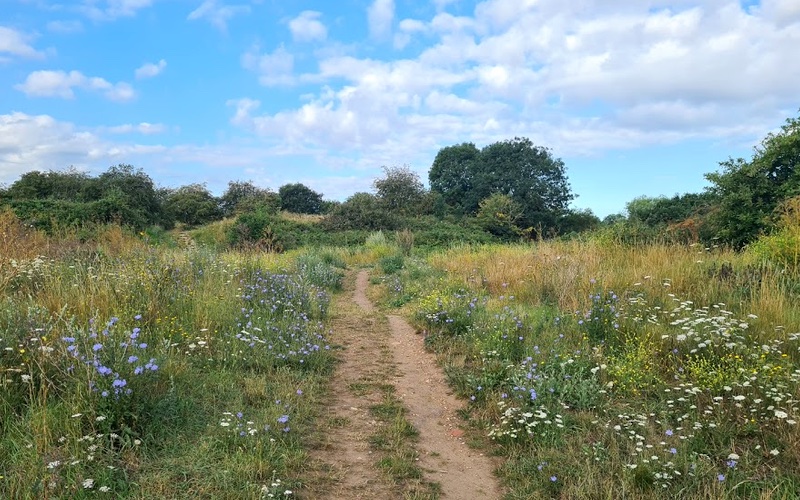
Embracing the concept of rewilding will help reduce biodiversity loss.
Of all the global-scale predicaments we currently face, I find biodiversity loss to be the most pernicious. The systematic, often wilful degradation of the source of our being and the accompanying depletion of the myriad wonders with which it is bejewelled, represent a deep source of personal pain and sorrow.
Furthermore, it’s an embedded phenomena. In 1987, I joined the Young Ornithologists’ Club and from the outset was haunted by the spectre of declining bird numbers reported through the pages of its quarterly publication. Later, I developed an interest in botany and lepidoptera and discovered these beset with the same issues: habitat destruction, poor land management, pollution and pesticides.
Across the board, it seems our relationship with nature is a dysfunctional one. This is doubly troubling for those of us who’ve had their lives immeasurably enriched through a love of nature, yet find ourselves complicit in its destruction by dint of being active in a system geared to that end. I’ve been carrying this baggage around for years. None of my school friends or subsequent work colleagues seemed conscious of these problems nor did they appear to care once awakened to them. Older folks, my parents included, dismissed the losses as collateral damage in the wake of ‘progress’. “Toward what?” I asked. A question invariably met with silence or a shrugging of shoulders.
However, lately it seems something has shifted. Awareness has spread and with it a commitment to change. Shoulders that once shrugged now seem set to carry the weight of the work ahead. Solutions are coming to the fore, most promisingly in the form of ‘rewilding’; the idea that depleted landscapes can be regenerated by allowing natural processes to re-emerge. In fact, it’s inaccurate to call rewilding an ‘idea’ as it’s now a proven model across Europe and well established in Britain as evidenced by the Carrigan Wildwood, Glenfenshie and Abernethy projects in Scotland and Ennerdale in northern England. The astonishing biological resurrection of the flagship British rewilding programme at the Knepp estate in Sussex and the bestseller status of ‘Wilding’, the story of its genesis by Isabella Tree, suggest this movement may be ready to roll out across the lowlands of southern England. Most recently, the ambitious WildEast initiative has pledged to rewild 250,000ha of East Anglia whilst simultaneously pushing the concept beyond the physical landscape and into the cultural practices and everyday lives of the areas’ inhabitants.
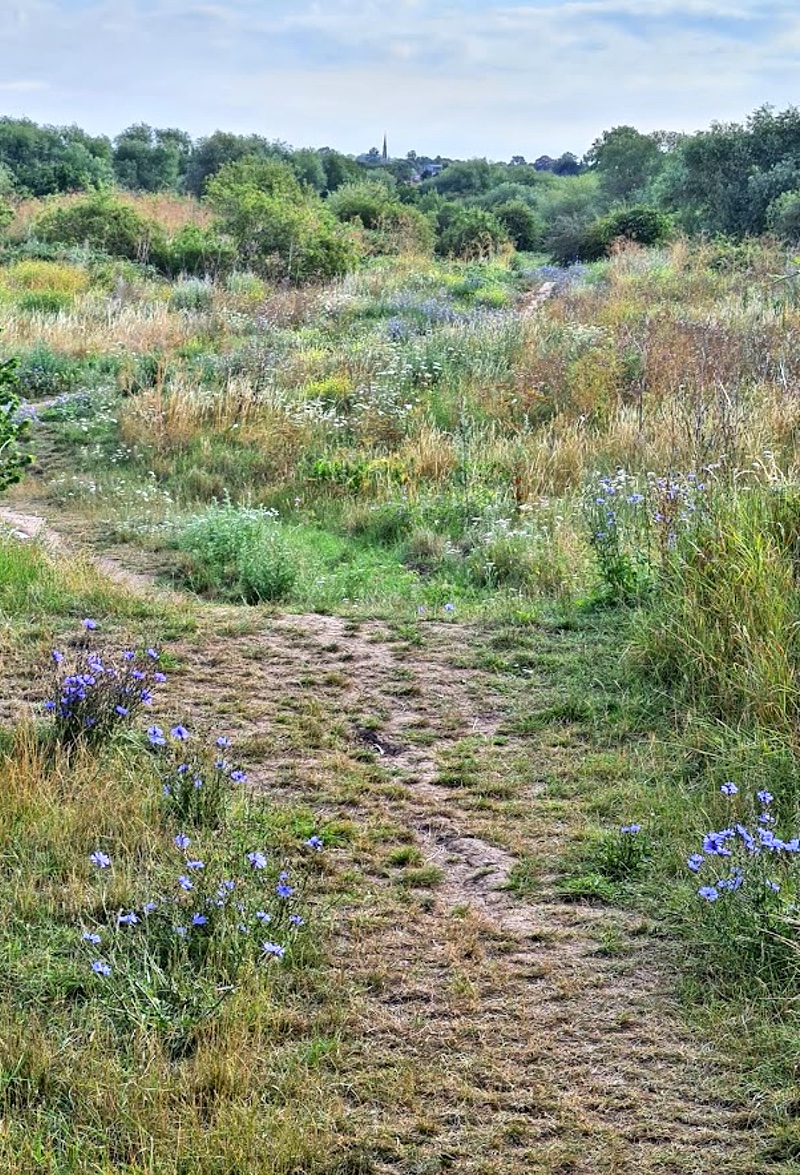
Rewilding allows once depleted landscapes to regenerate.
The acknowledgment of this cultural aspect emphasises a key point; rewilding is not just about the reinstatement of bison, beavers and wolves; nor does it necessitate the acquisition of vast tracts of land. Rewilding works on all levels to weave together the unravelled warp and weft of life’s rich tapestry and recognises humanity as an important thread.
Rewilding is also about wresting back dominion over consciousness from deceptive forces. We must first rewild ourselves before we can rewild our planet. What does that mean? Well, I’ve written previously on the Landscaping Solutions blog, of the need to relinquish our received wisdom around what constitutes ‘good gardening’ and acknowledge that we have increasingly been led down the garden path by snake oil salesmen. If you’re looking for evidence, consider how the ‘garden centre experience’ has changed over the past 30 years or so. Too many of our established practices are turning gardens into biological deserts when they are often the last refuge for wildlife in the face of habitat loss. As a reaction to this, I have, over the last couple of years, embraced the concept of rewilding in my own modest plot, and next month I shall share my experiences of that journey with you.
THE SUSTAINABLE AESTHETIC
In late 2019 we collaborated with Jilayne Rickards on a small urban garden she designed for a great client in North London. Jilayne christened the scheme ‘The Urban Retreat’.
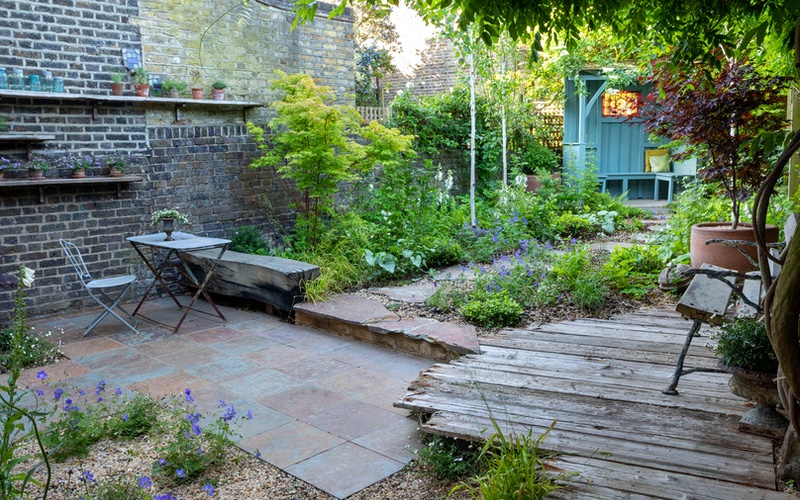
The Urban Retreat in North London, designed by Jilayne Rickards and built by Landscaping Solutions.
Jilayne’s vision was for the garden to be both beautiful and sustainable. In December last year we discovered the garden had picked up four British Association of Landscape Industries awards. The most satisfying of these for us was the award for best use of recycled and reclaimed materials. The recognition this garden received from BALI and the interest and acclaim it has garnered from the wider public offers hope for what we call ‘The sustainable aesthetic’. The more media coverage gardens of this type obtain the more they will come to be considered desirable by the general public and the more likely their guiding ethos will become mainstream thought.
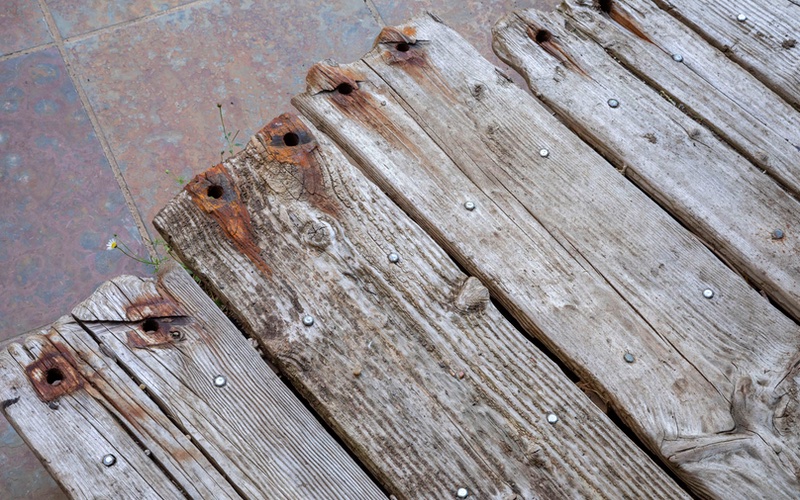
Reclaimed Douglas Fir decking, one of the many recycled and reclaimed materials used throughout the garden.
What is the ethos of the sustainable aesthetic and why is it important? The sustainable garden weathers well in the British climate, blends in with its surroundings, accommodates and encourages interaction with wildlife and does not damage the environment in its creation. It follows a number of principles;
Protect and nurture the holy trinity of soil, plants and insects. Do this and good things will follow. In ‘The Urban Retreat’ all soil was kept on site.
Reduce waste. In this garden all existing pots and planters were recycled along with the brick work. Paving sub-base materials were re-used where appropriate or sent for off-site recycling with any green waste produced. Energetic waste can also be reduced by designing closed systems and features that have multiple benefits. For example, planting Comfrey for its aesthetic appeal, ability to attract and feed insects, provision of composting material and medicinal applications.
We can further reduce waste by working with the existing lay of the land, soil type, microclimate, ‘hard’ and ‘soft’ vernacular, moisture levels, ‘habitat’ type, etc. The existing garden had a woodland edge feel and Jilayne used this to inform her plant choices. Woodland edge gardens are cooling and relaxing in the heat of a city summer.
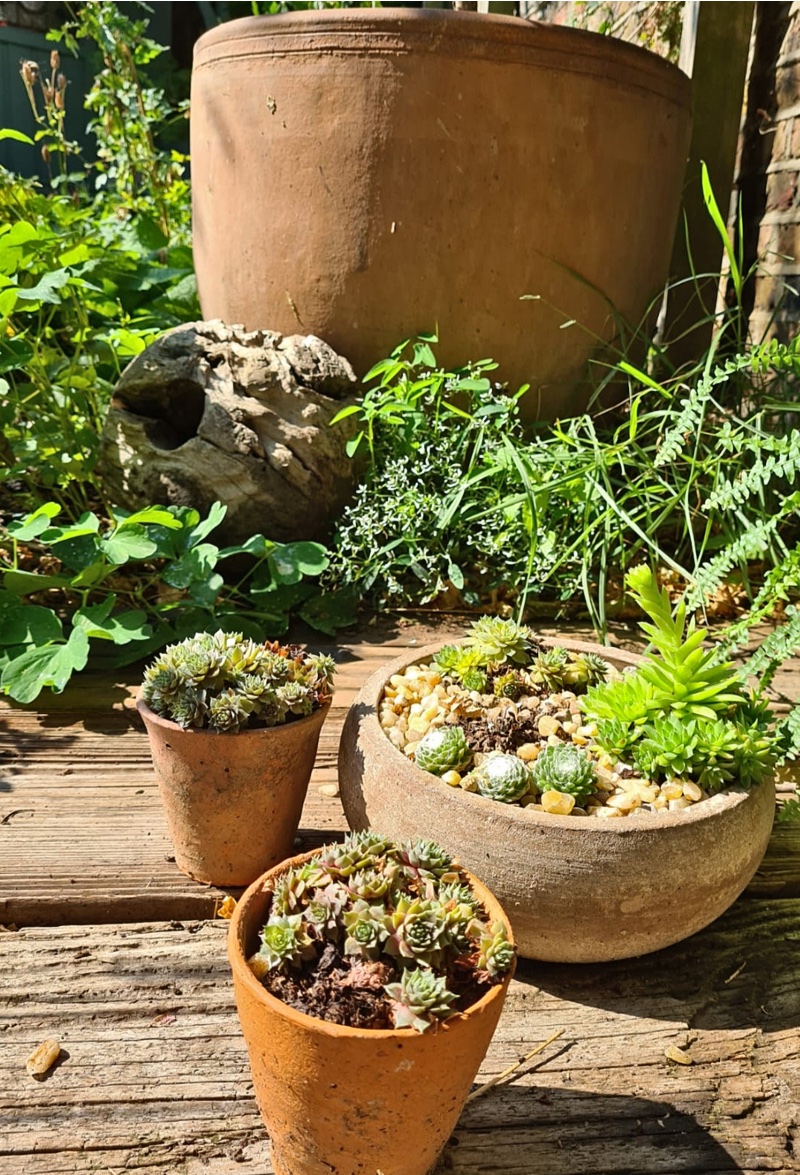
Existing pots and planters were recycled and wildlife friendly planting was retained.
Useful, wildlife friendly planting was retained and any unwanted plants were donated to other gardeners. A mature Elder was a prominent existing feature. What plant can better connect us to the environment and other lifeforms? In winter it looks a wreck and we wonder will it manage to limp on through to spring? But what a change once the sap starts to rise. The leaves come on early, connecting us to the cycle of re-birth out of decay. The summer flowers are an insect magnet and can be made in to refreshing drinks. The autumn berries feed birds and small mammals whilst boosting our immune systems through winter when processed in to medicinal food and drink. Dried out Elder canes are also the best material for the hand drill-one of the first ways our ancestors kindled fire. Try it yourself to fully appreciate their achievements! Plants of this kind re-connect us with our history and birthright and, in doing so, help dispel the illusion that we are somehow ‘outside’ of nature. Through constant exposure to the damaging aspects of our existence we have grown to believe degradation is our hallmark. Gardens are the one of the arenas in which we can reassert the positive elements of human intervention and perhaps see our purpose on this planet.
Specify plants and hardscape that don’t need mollycoddling. Opt for resilient plants and stone and timber types that don’t need constant sealing or cleaning. Reclaimed materials achieve this end and also tick the sustainability box- they have not been newly created and therefore no further finite resources have been consumed. In terms of timber, we used reclaimed Douglas Fir decking and shelving and reclaimed Oak for the seating block/retaining wall in this garden. Reclaimed slate and granite was used for the paving. Jilayne and the client went shopping in local markets for the second hand furniture, fixtures and fittings. All the reclaimed materials were of British provenance. When reclaimed wood cannot be used specify locally sourced FSC-certified timber from trusted suppliers.

Reclaimed timber, slate and granite were used throughout the garden as well as second hand furniture, fixtures and fittings.
Permeable surfaces allow rain water to percolate back in to the ground and to that end gravel was used extensively in this garden. More generally, look to make surfaces more porous with the aim of increasing biodiversity. Block and brick retaining walls could be replaced with gabions which allow unwanted existing materials such as paving and walling to be used as in-fill.
Sustainable gardens aim to be as ‘soft’ as possible. Planting should be diverse, successional and nectar-rich. Utilise a range of trees, shrubs, climbers, grasses and bulbs to provide food and shelter for wildlife. Don’t forget; attractiveness to humans is of equal importance if the garden is to be considered a success by the client!
Go easy on garden lighting and chemical weed and pest control. Neither were used in this scheme.
However, the garden wasn’t a perfect example of sustainability. There were a number of areas where our activities were damaging;
- Cement and adhesives were used. Both material have a high environmental impact.
- Fossil fuels were consumed and pollutants produced in travelling to and from site.
- Space restrictions dictated all deliveries were bagged. To reduce waste specify loose deliveries wherever possible.
- Gravel extraction degrades wildlife habitat.
How can we improve? At Landscaping Solutions we are committed to continual professional development through seminars, courses, workshops and personal study. Integration of environmental assessments to our CDM process helps us think about how we can reduce our impact and guides our landscape design decisions and installation techniques. This is a great tool but can only take us so far due to the fact that much of the raw information is based on intuition. There is a need to develop an industry accepted framework to help us better understand the relative impact of various materials and practices. For instance, we might assume artificial turf to be more impactful than paving but in some instances artificial turf allows the ground to ‘breath’ more than paving. Leave artificial turf to its own devices and it develops into ‘habitat’ much quicker than paving, rapidly hosting an array of plant and invertebrate life. However, can it be recycled satisfactorily? And which of these is most environmentally impactful; quarried British Yorkstone or Italian porcelain? What about quarried Indian sandstone v Italian porcelain? Or Indian sandstone v Indian porcelain. Yorkstone v Portland Stone? Portland stone from open cast extraction v undersea deposits? These are complicated questions.
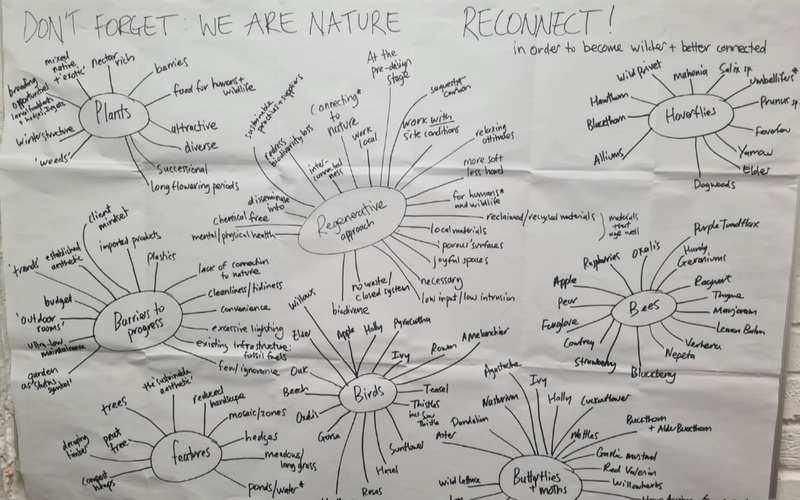
Regular brainstorming sessions helped guide our design decisions and installation techniques.
Good reliable information will enable us to compile a database of suppliers employing sustainable practices. For ‘The Urban Retreat’ we used Ashwells Timber and CED Stone.
Responsive clients might be encouraged to engage with food production be it wild or cultivated and on whatever scale possible. This takes the pressure off the industrial agricultural system, promotes personal resilience, self-sufficiency, understanding of our role in the ecosystem, empathy with other life forms and mental and physical health. Studies have shown low-input vegetable and fruit allotments to be the most biodiverse land use in the country. They can be further improved by providing a body of water and adding on-site composting facilities.
One last piece of advice; don’t forget to have fun!
CHANCE FOR CHANGE - REVIEWING OUR BUSINESS PRACTICES
Rather than going back to the way things were before COVID-19, Landscaping Solutions MD Ben West says we now have a chance to review our business practices.

“Stop the world I want to get off!” We have probably all said it. The current cessation of ‘business as usual’ offers us all the opportunity for serious contemplation on the trajectory of our species. A rare period of respite from the rat race. COVID-19 has enabled us to step outside ‘the machine’ for a new perspective. A chance to make collective changes to it or personal changes to our lives within it. We are usually so seduced by its gears and gadgets we fail to pay full attention to its failings. Perhaps that’s why the children have been leading the way. Not yet indoctrinated, they are free to see its inner workings with unfettered clarity. Witness how they turned away in disgust upon seeing how all things are mangled up in its motors.
The manner in which the machine has been so swiftly brought to its knees is alarming and, in light of the looming climate situation, highly likely to reoccur. Do we really want to continue with business as usual? Can we reorganise ourselves in a way that works harmoniously with nature and recognises humanity’s role in the web of life, a key part of the puzzle rather than a puzzled interloper?
All the recent turmoil - Brexit, COVID-19, climate change - sees humanity at a crossroads, forced to reflect on the next step. What kind of creatures are we? What kind of creatures do we want to be? What kind of world do we want to live in? What relationships do we wish to cultivate with all other creatures and our planet? Do we really want business as usual, as destructive as that has been?
It’s also time for our industry to reflect on these questions. How much of what we have achieved through landscaping and design has been beneficial? For every client with a ‘no maintenance’ outdoor room, every unsustainable show garden, every neatly manicured park, there’s a child labourer, a polluted waterway, a displaced aboriginal or a degraded peat bog. How does this make us feel? Can we continue to turn a blind eye? What do the young people we so desperately covet make of our industry? Are they enamoured with its current state? We need to reimagine ourselves so as to be as attractive as possible to the best of their talent, those wanting to join a movement leading the way and making a difference.
Humanity has the tools to shape its visions, God-like in its ability to manipulate itself, culture and landscape. First, it must clearly define the vision for which it strives. Much current decision making is under the stewardship of those exploiting the planet and its inhabitants in order to turn a short-term profit or maintain power. Will heightened awareness of the planet’s plight and its exploited societies and cultures reach enough of a crescendo to turn the tide?
Rather than business as usual we need a paradigm shift. Without structural revolution we are due to experience more of the same, but exponentially worse. How can we allow ourselves to consider going back to business as usual? Let’s use this time constructively by listening to what nature is telling us and then planning how to emerge transformed. People are looking for leadership. As landscape professionals, we are closer to nature than most and therefore better able to understand what the ‘new world’ needs to look like in order to go forward in a sustainable and regenerative manner. It is our duty to win over as many hearts and minds as possible. If we fail to rise to the challenge, there may soon be no business to go back to.